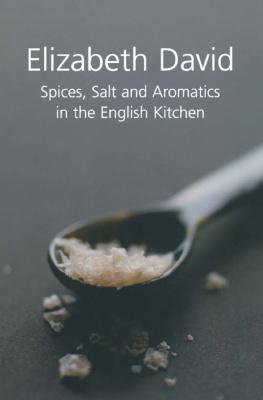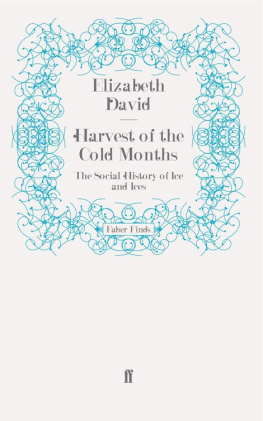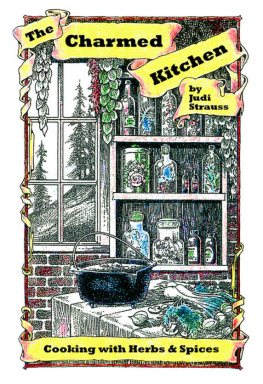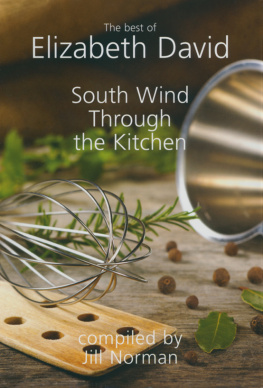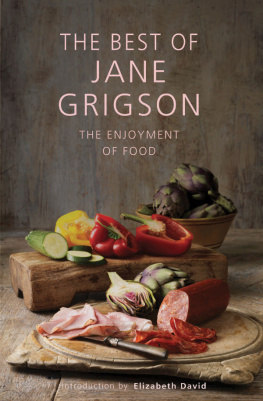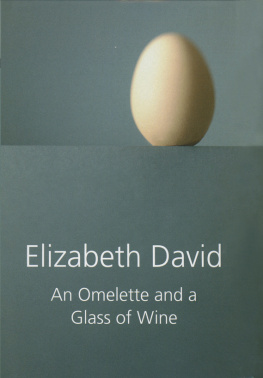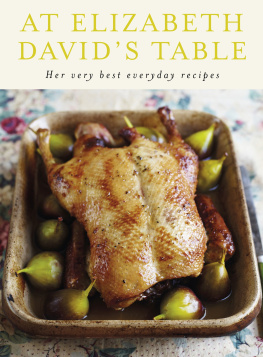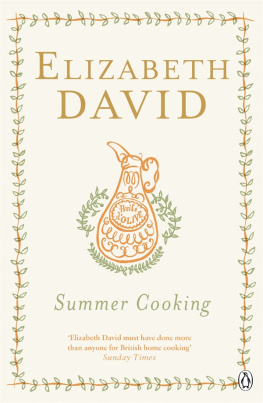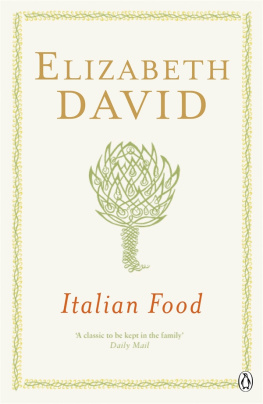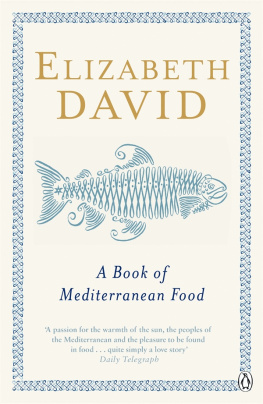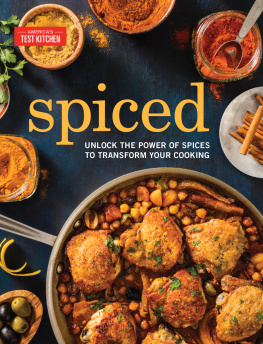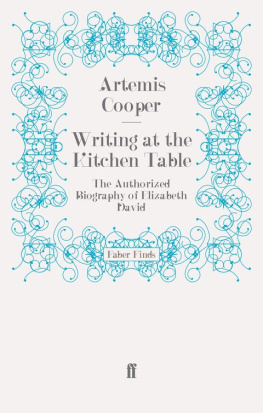Elizabeth David
Spices, Salt and Aromatics
in the English Kitchen
GRUB STREET LONDON
This edition published by
Grub Street
4 Rainham Close
London SW11 6SS
food@grubstreet.co.uk
www.grubstreet.co.uk
Text copyright Elizabeth David 2000
Copyright this edition Grub Street 2000
Reprinted 2003, 2006, 2008, 2010, 2011, 2013
First published in Great Britain by Penguin Books Ltd, 1970
British Library Cataloguing in Publication Data
David, Elizabeth, 1913
Spices, salt and aromatics in the English kitchen
1. Cookery (Spices) 2. Salt 3. Aromaticplants 4. Cookery
English
I. Title
641.5942
ISBN 978-1-902304-66-3
All rights reserved. No part of this publication may be reproduced, stored in a retrieval system, or transmitted in any form or by any means, electronic, mechanical, photocopying), recordingor otherwise, without prior permission of the publisher.
Printed and bound in India by
Replika Press Pvt. Ltd.
* * * * * * * * * * * * * * * * * * * * * * * * * * * * * * * * * * * * * * * * * * * * * * * * *
Contents
* * * * * * * * * * * * * * * * * * * * * * * * * * * * * * * * * * * * * * * * * * * * * * * * *
FOR some two thousand years, English cookery has been extremely spice-conscious, not surprisingly to anyone in the least familiar with the history of the spice trade in Europe and the part played in it, successively, by the Phoenicians, the Romans, the Arab conquerors of Spain, the Norman crusaders, the merchants of Venice and Genoa, the religious orders which fostered the arts of healing, medicine and distillery, the Portuguese explorers who opened the sea route to the Indies, the Dutch empircbuilders who wrested the spice trade from Portugal, the British East India Company whose merchants in their turn made London for two centuries the greatest spice mart in the world.
It is often believed that the lavish use of spices in old English cooking can be explained by the necessity to mask hal-decayed food and to give zest to a monotonous diet of salt meat and boiled fish. To some extent, these deductions are no doubt correct. Surely, though, there are other reasons, one of them being quite simply that the English have a natural taste for highly seasoned food as do most northern people and since trade with the Near East and southern Europe brought us early in the evolution of our cookery considerable opportunities for indulging the taste, we took to spiced food with an enthusiasm which seems to have been almost equal to that shown by the Romans at the height of their preoccupation with the luxuries of living. A study of English recipes of the fifteenth century leaves one with the impression that to the cook the spices were a good deal more important than the food itself. One or two published manuscriptsDried fruits, such as dates, figs, raisins and currants, were imported from Greece, the Levant and Spain. Together with quantities of almonds and pine nuts commonly used at that time the dried fruits were freely mixed with meat and fish stews, pies and pasties. Vegetable colouring from herbs, roots and flowers saffron was the most highly prized were other auxiliary ingredients of much importance. Pomegranates were evidently familiar in European and English cooking in the fifteenth and sixteenth centuries, for the seeds were used for decoration florsche it about with pomegarnett seeds is a recurring instruction in these recipes. One late-sixteenth-century author, Sir Hugh Plat, describes a method of keeping pomgranats fresh til Whitsundtide.
Cookery books and manuscripts should not, however, be taken as representing the whole picture of what any given people were eating at the period they were written. They are simply indications of the general character of the food and of the ingredients available to those who could afford them. It seems unlikely that dishes so extravagantly spiced, sweetened and coloured were eaten very often, even by those rich enough to buy such luxuries, for luxuries they were, and it has to be borne in mind that until the late-seventeenth century, recorded recipes, in England as elsewhere in Europe, were predominantly those of the royal households, of the nobility, the great land-owning barons, the princes of the Church, and the prosperous merchants whose prestige demanded a visible parade of wealth as much upon their tables as in the matter of personal adornment. In Europe, spices were the jewels and furs and brocades of the kitchen and the still-room. Medicine and pharmacy also were dependent upon tinctures and oils and elixirs extracted from roots and leaves, herb and spice plants, and their fruit and seeds. Pepper and cloves and juniper branches were burned to sweeten the air in the houses of the rich, lavender and rosemary were strewn on the floors, potent honey-based drinks such as mead, hydromel and metheglin were heavily spiced and scented with musk, ambergris, roses, violet leaves, marjoram, honeysuckle, cinnamon, ginger and sweet briar. It seems not to have occurred to anybody at this time that so many aromatics and flavourings ended in cancelling each other out.
It was mainly from the far Orient, overland via Arabia and the Red Sea, Egypt, and the ports of Venice and Genoa that spices reached England. Venetian merchants, strategically situated midway between the Levant and Western Europe, became the great middlemen of the spice trade. They sent their cargoes to Flanders and the Low Countries and to England in galleys which, until the end of the fifteenth century, were a common sight in the ports of Southampton and Rochester.
Alas for Venice. The virtual monopoly of the European spice trade which had made the Serene Republic rich who knows which palaces, now crumbling to their ruin on the Grand Canal, were indirectly subsidized by the spice-hungry English was doomed. One day in May 1498 the Portuguese explorer Vasco da Gama anchored his ship off the port of Calcutta. The sea route to the Indies was discovered at last. Three months later da Gama set off on his return voyage to Lisbon, bearing news that the ruler of Calicut was prepared to barter cinnamon and cloves, ginger and pepper, in exchange for gold and silver and, curiously, scarlet cloth. No longer would Europe be dependent upon the complicated overland route from the East, no longer would the Arab traders, the Sultans of Egypt, the port officials of Alexandria, the dealers of Venice, be in a position to exact their heavy tolls and set their own price on the luxuries they had made necessary to European life.
Thirty years after Vasco da Gamas discovery of the sea route to India, although the galleys of Venice were still to be seen in English ports, their cargoes were no longer spices but glass and other things of no value. The European spice trade had passed into the hands of the Portuguese, who held on to it with difficulty for a century, only to lose it to the Dutch, whose trade with Java and the Spice Islands, as the Moluccas came to be known, led to the formation in 1602 of the powerful Dutch East India Company. By the sixteen-eighties the Dutch had established almost total monopoly of the highly profitable trade in cloves and nutmegs, while the Portuguese retained a corner in the cinnamon business.
At this period, English cooking was still heavy with ginger and pepper, cinnamon, cloves, nutmeg and sugar. The food of Italy and Portugal, Flanders, France, Holland and Germany was similarly spiced and scented. It was not until towards the middle of the seventeenth century, when the British East India Company, originally formed by the merchants of London in 1600, had become a power to reckon with, that English cooking began to develop along lines which we can recognize today. Spices and sugar were more readily available and became relalively cheap, were therefore less prized and used with more discretion. More varieties of vegetables and fruit were grown, the urge to disguise every piece offish, flesh or fowl as something else seems to have abated, at least temporarily, although spices were still very much used as they are today in the puddings, cakes, pickles and wines made in the houses of the gentry. Spiced drinks were a fashionable fad as well as remedies for all of the pocket nutmeg graters which became such a beautiful and practical fashion of eighteenth-century England; and the elegant silver cinnamon casters or muffineers of the Georgian period were another by-product of the fashion for sprinkling spices on food and into drinks.
Next page
